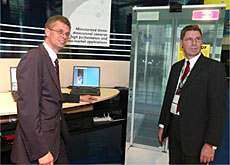Swiss pioneer mini 3D camera

A revolutionary electronic eye produced by a Swiss firm has won Europe’s most important information technology prize.
The intelligent camera, which is the size of a cigarette packet, produces three-dimensional images. It took 20 years to develop.
The result of a collaboration between the University of Neuchâtel and the private sector, the camera, known as ESPROS/TOF, is set to revolutionise all areas where photocells are currently used.
Its reliability and, above all, the applications that it opens up for the future have made it one of the year’s most significant innovations.
It won its creators Europe’s most prestigious award, the €200,000 (SFr309,000) IST (Information Society Technologies) prize.
Innovative features
Project leader Peter Seitz, an associate professor at the University of Neuchâtel, is clearly proud that this goal has been achieved.
“This is the Nobel prize for innovation in the field of information technology,” he said.
Engineer Beat De Coi told swissinfo that despite the camera’s very small size, it could still provide a range of information about its surrounding space.
This means that a lift fitted with the camera will detect someone approaching, then open and close the door with pinpoint precision.
There are also plans to make, in the near future, intelligent airbags that will only inflate at the right moment, at the pressure required to avoid injuries to passengers that today are still inevitable.
And there are other applications. “By monitoring chest movements, the camera could in future prevent cot death in newborns. If the newborn’s breathing ceases, the alarm goes off,” said De Coi.
Light technology
The technology-laden little box applies a very new principle. An ordinary digital image records on pixels light reflected by objects in the environment.
ESPROS/TOF can also do this. But there is more to the new camera: around the lens, it has infrared sources that emit light invisible to the human eye.
The microprocessor hidden behind the lens can also record infrared rays and calculate the time required by the beam of light to cover the distance from camera to object and back.
The system is very similar to conventional radar, which monitors the speed of motor cars and locates objects in space. But ESPROS/TOF is the first to exploit the time-of-flight principle of measuring the time taken by particles to cover a set distance.
The distance is recorded on each individual pixel and permits the calculation of the exact position of all objects in the space observed.
It is possible to monitor any movement in an environment from the image sequence produced by digital recording.
Commercial production
In the mid-1980s, digital imaging technology was in its infancy and, like most basic research, still confined to universities.
Two early enthusiasts were Seitz and De Coi, a student at the time. When they met in the early 1990s, they were already mulling over the idea of an intelligent camera.
For almost 20 years, De Coi has been managing director of CEDES, a company based in canton Graubünden with 130 employees that is a world leader in the manufacture of photocells.
But a secure market position is not enough. “A small company cannot afford a complete research laboratory that pursues projects for years with no guaranteed commercial return,” explained Seitz.
In this case, the solution was called CSEM SA, a mixed-equity company with public and private capital that aims to provide a link between academia and the real economy.
Thanks to the practical and financial support of CEDES, research was transformed into a product. The 3D eye has finally emerged from the academic world and is poised to conquer new markets.
swissinfo, Daniele Papacella
The ESPROS/TOF is an intelligent 3D camera the size of a cigarette packet.
It uses a system similar to conventional radar to calculate the exact position of objects.
The new technology opens up a large number of safety and security applications.
It was developed by scientists in Neuchâtel and is produced by CSEM, a mixed equity company.

In compliance with the JTI standards
More: SWI swissinfo.ch certified by the Journalism Trust Initiative

You can find an overview of ongoing debates with our journalists here . Please join us!
If you want to start a conversation about a topic raised in this article or want to report factual errors, email us at english@swissinfo.ch.